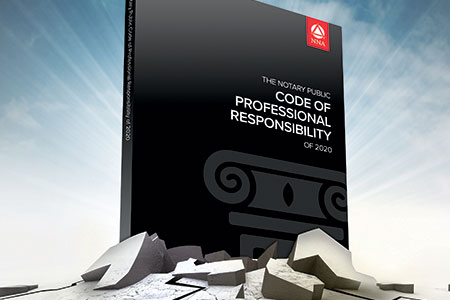 This article in our continuing series on The Notary Public Code of Professional Responsibility of 2020 covers a topic that should be near and dear to every Notary: the matter of reasonable care.
This article in our continuing series on The Notary Public Code of Professional Responsibility of 2020 covers a topic that should be near and dear to every Notary: the matter of reasonable care.
As the Commentary to Guiding Principle V explains, “reasonable care” is the standard for avoiding legal liability. Let’s say an individual files a claim against your Notary insurance policy because they suffered a financial loss from a notarization you performed. In investigating the claim, your surety company or insurer will apply the standard of reasonable care to determine whether you are liable.
There is good news about reasonable care: To avoid liability, Notaries don’t have to perform notarizations perfectly. If perfection were the standard, no one could attain it, and no one would be a Notary. Instead, the standard for reasonable care is the carefulness demonstrated by an ordinarily prudent Notary in similar circumstances (Standard V-A-1).
While Notaries don’t have to be perfect, they must be careful. This focuses the discussion away from liability to the Code’s broader concern for Notaries to act responsibly. Quoting the Commentary again, “Reasonable care is a higher standard than mere minimally acceptable performance. Indeed, although the frequent synonym for reasonable care is ordinary care, Notary professionals must strive to rise above ordinary performance. The intent of placing this matter in the Code is to underscore its significance and encourage conduct comprehensive enough to assure satisfaction always — thereby achieving better performance than basic compliance.”
Some examples will help illustrate the carefulness that goes beyond basic compliance:
There are state laws that say a certificate of notarial act must either be “endorsed on or attached to the instrument” (for example, see Cal. Gov’t Code 8205[a][2]). Just how to attach a certificate to a document is not indicated. Minimum compliance might suggest using a paperclip. Carefulness requires using a stapler (Standard IV-C-1).
A Notary may be in a state without a requirement for the Notary to assess if a document signer is mentally competent before completing the notarization. While performing the notarization without screening for mental competence might satisfy basic compliance, the Code requires a careful Notary to do so (Standard III-C-2).
Few, if any, states have a rule requiring all elements of a completed notarial certificate to appear on the same page. Better practice and reasonable care would necessitate the acknowledgment or other notarial wording and the Notary’s signature and seal to always be on the same page.
State law may be silent on the matter of securing the seal when it is not in use. The careful Notary will keep the seal in a secure area at times when it is not in use to prevent its misuse (Standard VI-B-1).
Citing the Code Commentary in conclusion, “Especially as technology advances, as the financial values of documents steadily rise, as fraudsters engage in ever-increasing efforts at identity thefts and document frauds, and as the roles of Notaries become more expansive and complex, Notaries would be well advised to exercise care, diligence, and prudence beyond the lowest common denominator of reasonableness.”
Bill Anderson is the NNA’s Vice President of Government Affairs and Drafting Coordinator for The Notary Public Code of Professional Responsibility of 2020.